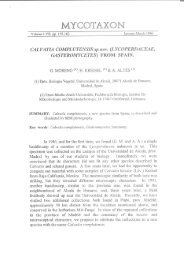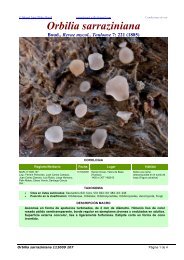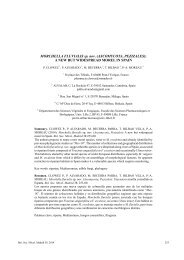Ramalina carminae (Ascomycota: Ramalinaceae), a new species from Europe
You also want an ePaper? Increase the reach of your titles
YUMPU automatically turns print PDFs into web optimized ePapers that Google loves.
Rosario Arroyo, Estela Seriñá and Elena Araujo<br />
<strong>Ramalina</strong> <strong>carminae</strong> (<strong>Ascomycota</strong>: <strong>Ramalina</strong>ceae), a <strong>new</strong> <strong>species</strong>...<br />
tand it. From Acharius (1810) to the present, numerous<br />
studies have dealt with the taxonomy of this group which<br />
includes <strong>Ramalina</strong> polymorpha (Ach.) Ach., R. capitata<br />
(Ach.) Nyl., R. protecta H. Magn., R. strepsilis (Ach.)<br />
Zahlbr. and R. digitellata Nyl. In some cases this taxa can<br />
be distinguished morphologically, however intermediate<br />
forms often appear, which has led to a permanent discussion<br />
over its taxonomic position. Some authors (Krog &<br />
James 1977, Krog & Østhagen 1980) recognized a single<br />
<strong>species</strong> <strong>Ramalina</strong> polymorpha (Ach.) Ach. with different<br />
morphotypes, but this synthetic approach has not been accepted<br />
by other authors who have recognized in the group<br />
two <strong>species</strong>: <strong>Ramalina</strong> polymorpha (Ach.) Ach. and R. capitata<br />
(Ach.) Nyl. (Santesson 1984, Sancho 1988, Nimis<br />
& Poelt 1987).<br />
This two <strong>species</strong> were recognized in the chemical and<br />
morphological study of the <strong>Ramalina</strong> polymorpha group<br />
in Spain (Arroyo et al. 1991) which was based on 891 specimens.<br />
This study also suggested to treat the different<br />
morphotypes observed among R. capitata, which is a very<br />
polymorphic <strong>species</strong>, especially in the Mediterranean area,<br />
as varieties. Nimis (1993) gave an infraspecific range to<br />
this morphotypes: R. capitata (Ach.) Nyl. var. capitata,<br />
R. capitata var. protecta (Magnusson) Nimis and R. capitata<br />
var. digitellata (Nyl.) Nimis.<br />
In the present work, mainly based on material collected<br />
by the authors, we describe a <strong>new</strong> <strong>species</strong> <strong>from</strong> Portugal,<br />
Spain and Sardinia (Italy). The <strong>new</strong> <strong>species</strong> is associated<br />
to the different varieties which, according to Nimis<br />
(1993) we accept among R. capitata. We will refere to these<br />
varieties as <strong>Ramalina</strong> capitata complex.<br />
MATERIALS AND METHODS<br />
The first material studied (67 specimens) was collected by<br />
the authors on several field trips in the Tiermes archaeological<br />
site, at Montejo de Tiermes (SW of the province of Soria, Spain).<br />
We have done the <strong>Ramalina</strong> genus revision (year 2007) in different<br />
national and international herbaria and we found two specimens<br />
<strong>from</strong> Sardinia (Italy) and three <strong>from</strong> Portugal, which are<br />
identical in its morphology as well as in its chemical composition<br />
to those presented in this work. 140 specimens collected by<br />
the authors and other different collectors between 1967 and 1990<br />
in different Spanish locations were provisionally included into<br />
the <strong>Ramalina</strong> capitata complex as atypical specimens. All this<br />
samples as well as recent collections (37 specimens) have been<br />
assimilated to this <strong>new</strong> <strong>species</strong>.<br />
All specimens (249) deposited in BCN, LEB, MACB, MAF,<br />
PO and TSB, were examined with standard techniques by using<br />
stereoscopic and compound microscopes. A short-list was examined<br />
and photographed using a Nikon SMZ 1500 stereomicroscope<br />
and a Nikon Eclipse 80i microscope fitted with bright<br />
field (BF) and differential interference contrast (DIC), both coupled<br />
to a Nikon DXM 1200F digital camera. To combine successive<br />
photographs at different focal levels we used the free<br />
Public Domain software CombineZ5 by Alan Hadley<br />
(http://www.hadleyweb.pwp.blueyonder.co.uk).<br />
Secondary metabolites of all specimens were identified by<br />
thin-layer chromatography (TLC) using solvent systems A, B,<br />
C (Culberson & Kristinsson 1970, Culberson et al. 1981, Huneck<br />
& Yoshimura 1996, Orange et al. 2001). Ochrolechia parella<br />
(MACB 60317) was used as standard for the variolaric acid.<br />
Measurements (width of the branches and diameter of the soredia)<br />
were calculated by using 10 samples of each morphotype<br />
in the complex and the results are given as minimum value observed<br />
(in brackets) followed by average value obtained and maximum<br />
value observed (in brackets).<br />
RESULTS<br />
<strong>Ramalina</strong> <strong>carminae</strong> R. Arroyo & E. Seriñá sp. nov.<br />
Thallo saxicolo, erecto, caespitoso vel subpendulo, rigido, usque<br />
ad 6 cm longo, cinereoflavescente. Laciniae applanatae, irregulariter<br />
divisae, ramificatione intricate, rugulosostriatae et pro parte majore<br />
dichotomae. Soraliis numerosae lateralia et terminalia, sorediis granulosi.<br />
Apotheciis ignotis. Thallo K-; medulla K+, KC+ P-; UV-. Acidi<br />
variolarici et usnici continens.<br />
Typus: SPAIN: SORIA: Montejo de Tiermes (Archaeological Site),<br />
UTM: 30T48721 457519, 1150 m alt., N-NW exposure, sandstone,<br />
28 August 2007, M. J. Pérez Alonso (Arroyo 4284) (100.000 MACBholotypus;<br />
H, MA, UPS-isotypi) (Figs. 1-6).<br />
Thallus shrubby, erect to subpendulous or rarely caespitose,<br />
rigid, yellow green to almost whitish in some areas<br />
which usually belong to branching points or changes in<br />
the branches width; profusely and irregularly branched.<br />
Branches with a matt and irregularly grooved surface, with<br />
veins projected specially in the lower face, irregularly shaped,<br />
frequently twisted and intermixed, giving a frayed appearance,<br />
of 1-6 cm length, (0.45-)0.78(-1.25) mm width<br />
in the base and up to (0.25-)0.58(-1.37) mm in the apices,<br />
showing a non-gradual variation and being common the<br />
expansion of the apices; cracks are common and they are<br />
frequently sorediate. Highly sorediate, especially in the<br />
upper part and particularly in the apical expansions. Soralia<br />
scattered, with a great morphological diversity, more<br />
diffuse in the apical parts, with trend toward labriform,<br />
or under the thin finger-shaped branches, more rarely capitate<br />
or helmet-shaped. Marginal and laminar soralia are<br />
better delimitated, more or less excavated. Some marginal<br />
soralia are clearly deeply concave. Others take a funnelshape<br />
covered in soredia and other capitate soralia, mainly<br />
6 Botanica Complutensis 35: 5-14. 2011






